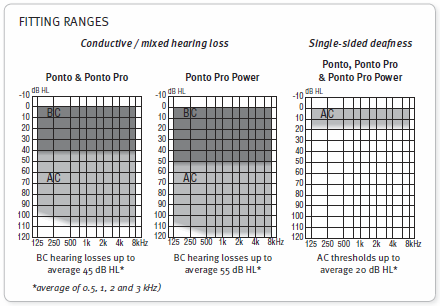Bone conduction hearing solutions convert sound into vibrations that are transmitted to the skull and subsequently the hearing ear.
Bone Conduction Hearing Solutions
Traditional hearing aids amplify air conducted sound and output air conducted sound directly into the external ear canal.
Bone conduction hearing solutions convert sound into vibrations that are transmitted to the skull and subsequently the hearing ear.
Candidacy
- Persons who have normal hearing or minimal hearing loss in one ear and are deaf in the other ear.
- Persons with uncorrectable conductive hearing loss but a normal inner ear.
- Uncorrectable conductive hearing loss due to infection
- Congenital (born) defects of the ear
- Traumatic defects of the ear.
- Example diagnosis that can produce this type of hearing loss scenario:
- Single Sided Deafness
- Sudden Unilateral Hearing Loss
- Acoustic Neuroma
- Atresia
- Microtia
- Treacher Collins Syndrome
- Goldenhar Syndrome
Sample Fitting Ranges For Various Products

Problems Addressed by a Bone Conduction Hearing Solution
- Hearing better in noise environments
- Hearing from the bad ear when in noise
- Hearing from the bad ear when the good ear is occupied on the telephone
- A bone conduction hearing solution does not help with telling direction of sound when the problem being addressed is a nerve-deaf ear on one side and a more normal ear on the other side
- A bone conduction hearing solution does help with direction of sound when one ear is normal and the second ear has a normal inner ear but a dysfunctional middle ear conductive system.
Specific Hearing Loss Criteria
- The bone conduction pure tones in the better ear must be equal to or better than 45 dB for 500 to 3000 Hertz.
- The patient should be unable to wear a hearing aid in the deaf or poorer hearing ear or a hearing aid should be an unacceptable nuisance in the poorer ear.
Bone Conduction Hearing Solution Choices
Click on the brand name in the left column in order to learn more about that specific solution.
| Solution Type | Insurance | Hearing Loss Severity Range | Comments | |
|---|---|---|---|---|
| Oticon Medical Ponto | Surgical | Typically covered, check with insurance | High power options available for more severe hearing loss | Customized accessories |
| Cochlear BAHA | Surgical | Typically covered, check with insurance | High power options available for more severe hearing loss | Customized accessories |
| Phonak CROS | Non-surgical | Possible but not typically covered, check with insurance | High power options available for more severe hearing loss | Customized accessories |